1998 CADILLAC ELDORADO tires
[x] Cancel search: tiresPage 15 of 380
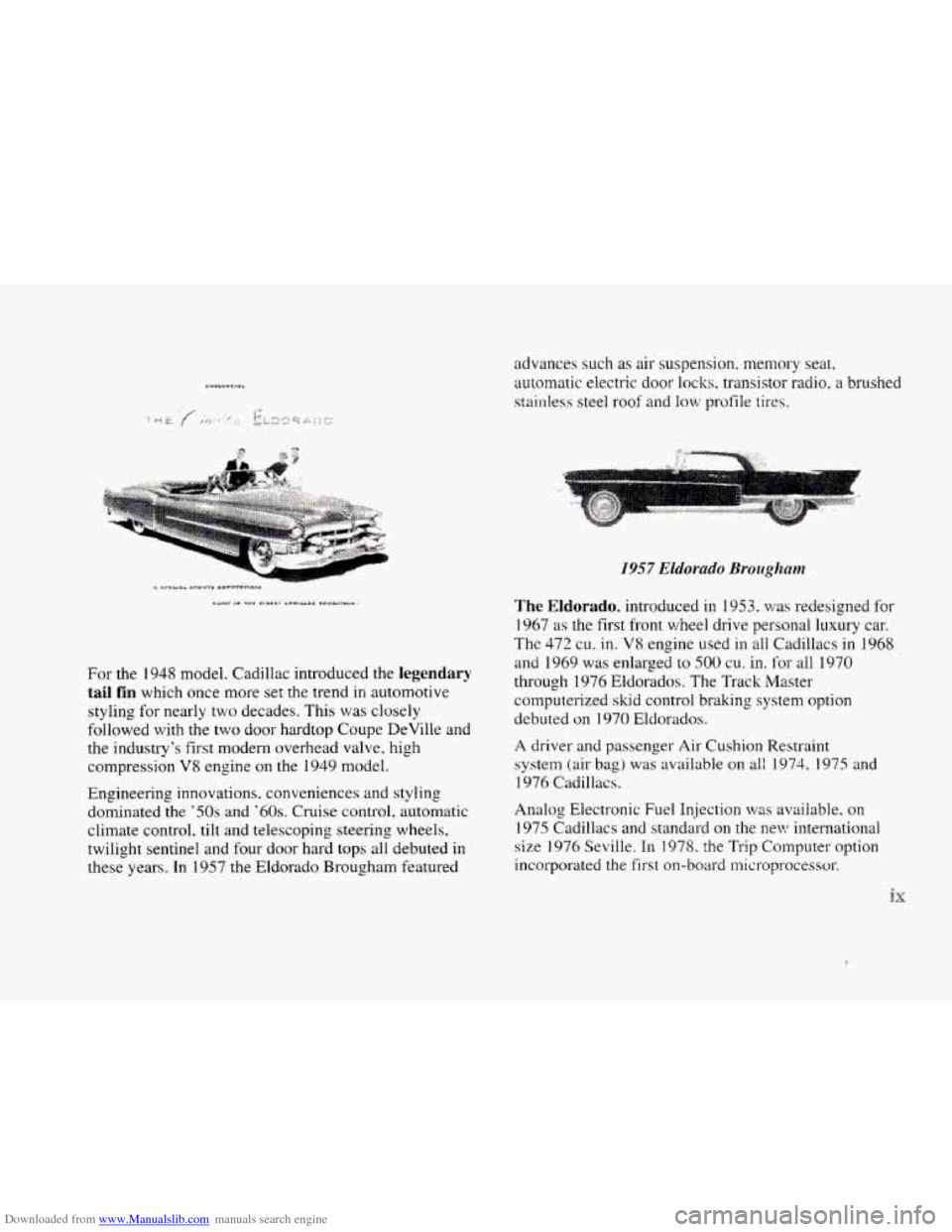
Downloaded from www.Manualslib.com manuals search engine For the 1948 model. Cadillac introduced the legendary
tail fin
which once more set the trend in automotive
styling
for nearly two decades. This was closely
followed with the two door hardtop Coupe DeVille and
the industry’s first modem overhead valve, high
compression
V8 engine on the 1949 model.
Engineering innovations. conveniences and styling
dominated
the ’50s and ‘60s. Cruise control, automatic
climate control.
tilt and telescoping steering wheels,
twilight sentinel and four door hard tops
all debuted in
these years. In 1957 the Eldorado Brougham featured advances
such as air suspension. memory seat,
automatic electric
door locks, transistor radio. a brushed
stainless steel roof and
low profile tires.
The Eldorado. introduced in 1953, wziS redesigned for
1967 as the first front wheel drive personal luxury car.
The
472 cu. in. V8.engine used in all Cadiilacs in 1968
and 1969 was enlarged to SO0 cu. in. for all 1970
through 1976 Eldorados. The
Track Master
computerized
skid control braking system option
debuted on
1970 Eldorados.
A driver and passenger Air Cushion Restraint
system (air bag) was available on
ali 1974. 1975 and
1976 Cadillacs.
Analog Electronic Fuel Injection
was available. on
1975 Cadillacs and standard on the new international
size 1976 Seville. In
1978. the Trip Computet. option
incorporated the first on-board microprocessor.
Page 130 of 380
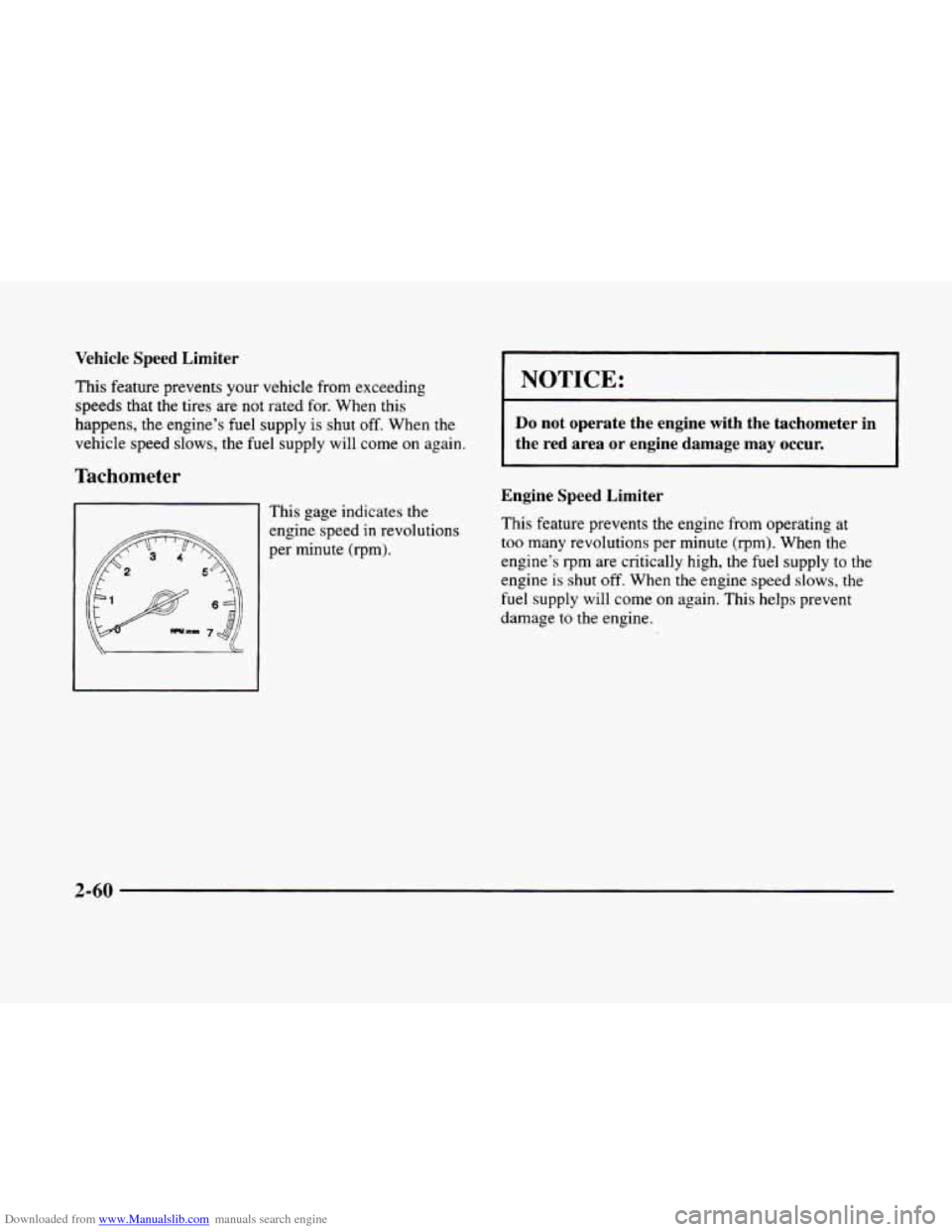
Downloaded from www.Manualslib.com manuals search engine Vehicle Speed Limiter
This feature prevents your vehicle from exceeding
speeds that the tires are not rated for. When this
happens, the engine’s fuel supply
is shut off. When the
vehicle speed slows, the fuel supply will come on again.
Tachometer
This gage indicates the
engine speed in revolutions
per minute
(rpm).
I NOTICE:
~~
Do not operate the engine with the tachometer in
the red area or engine damage may occur.
Engine Speed Limiter
This feature prevents the engine from operating at
too many revolutions per minute (rpm). When the
engine’s
rpm are critically high, the fuel supply to the
engine is shut off. When the engine speed slows, the
fuel supply will come
on again. This helps prevent
damage
to the engine.
2-60
Page 204 of 380
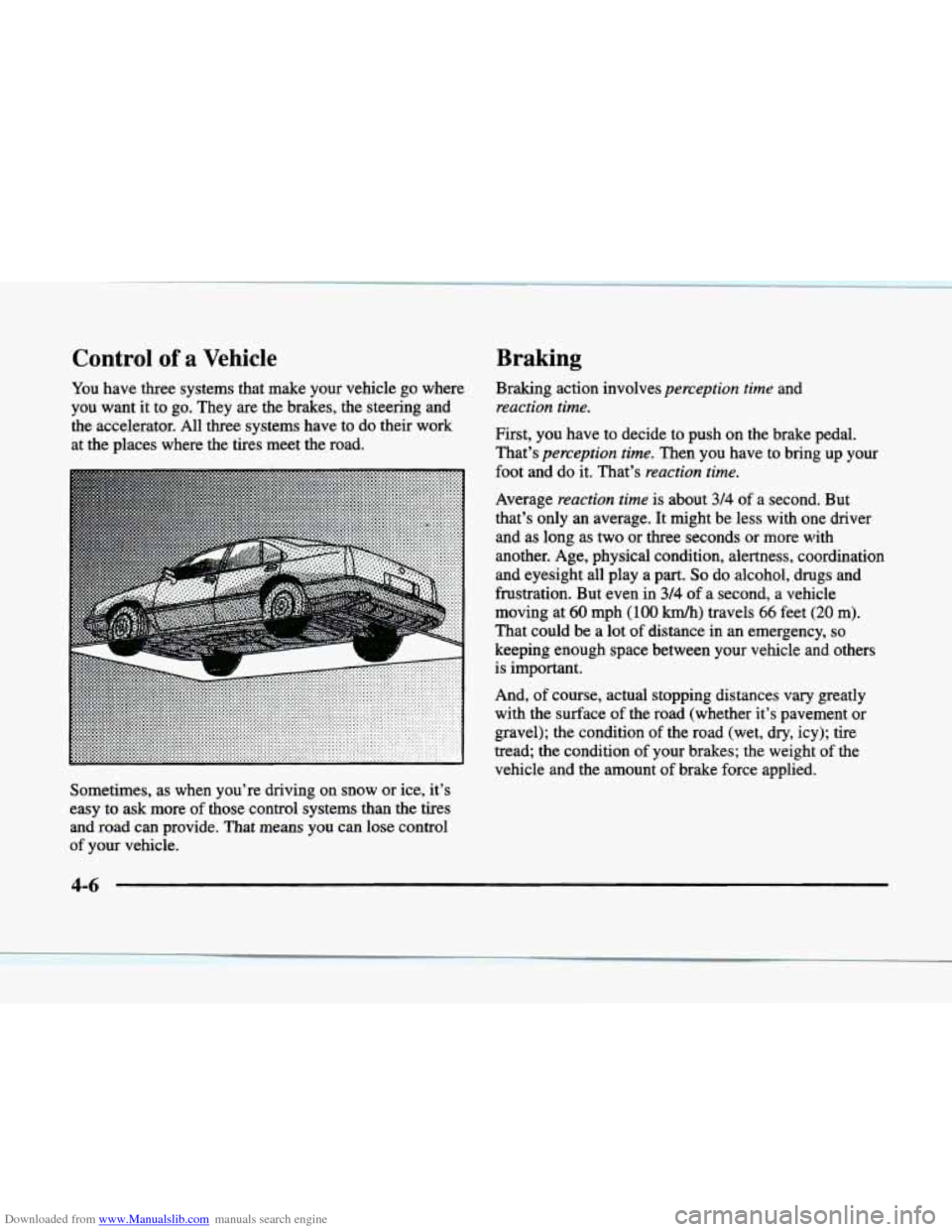
Downloaded from www.Manualslib.com manuals search engine Control of a Vehicle
You have three systems that make your vehicle go where
you want it to go. They are the brakes, the steering and
the accelerator. All three systems have to do their work
at the places where the tires meet the road.
L
-4
. . , . . . .
. . . . . . . ....... .....
P
Braking
Braking action involves perception time and
reaction time.
First, you have to decide to push on the brake pedal.
That’s
perception time. Then you have to bring up your
foot and do it. That’s
reaction time.
Average reaction time is about 314 of a second. But
that’s only an average. It might be less with one driver
and as long as two or three seconds or more with
another. Age, physical condition, alertness, coordination
and eyesight all play a part.
So do alcohol, drugs and
frustration. But even in
3/4 of a second, a vehicle
moving at
60 mph (100 km/h) travels 66 feet (20 m).
That could be a lot of distance in an emergency,
so
keeping enough space between your vehicle and others
is important.
And, of course, actual stopping distances
vary greatly
with the surface
of the road (whether it’s pavement or
gravel); the condition
of the road (wet, dry, icy); tire
tread; the condition of your brakes; the weight
of the
vehicle and the amount of brake force applied.
Sometimes, as when you’re driving on snow or ice, it’s
easy to ask more of those control systems than the tires
and road can provide. That means you can lose control
of your vehicle.
4-6
Page 209 of 380
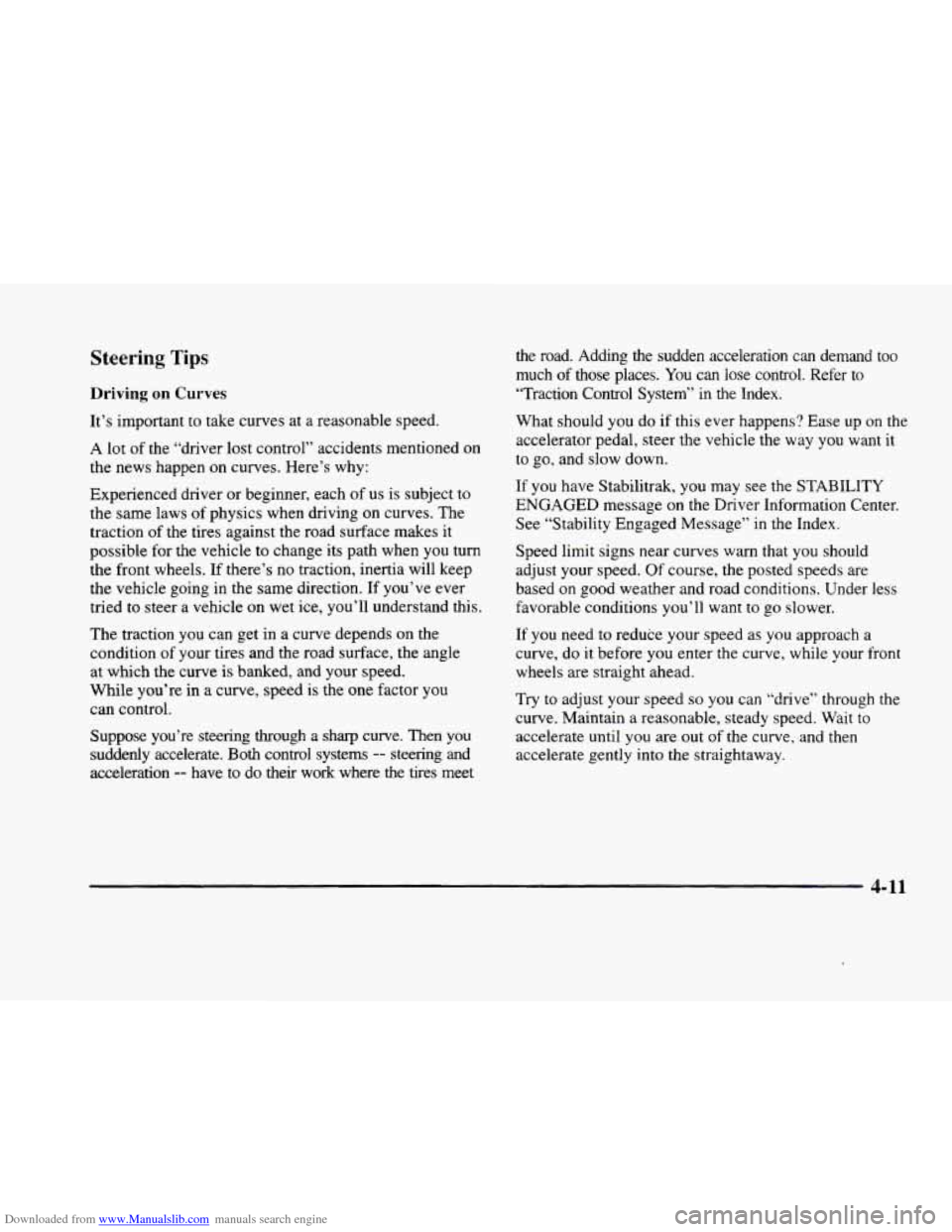
Downloaded from www.Manualslib.com manuals search engine Steering Tips
Driving on Curves
It’s important to take curves at a reasonable speed.
A lot of the “driver lost control” accidents mentioned on
the news happen on curves. Here’s why:
Experienced driver or beginner, each of
us is subject to
the same laws of physics when driving on curves. The
traction of the tires against the road surface makes it
possible for the vehicle to change its path when you turn
the front wheels. If there’s no traction, inertia will keep
the vehicle going in the same direction. If you’ve ever
tried
to steer a vehicle on wet ice, you’ll understand this.
The traction you can get in a curve depends
on the
condition
of your tires and the road surface, the angle
at which the curve
is banked, and your speed.
While you’re in a curve, speed is the one factor you
can control.
Suppose you’re steering through a sharp curve. Then you
suddenly accelerate.
Both control systems -- steering and
acceleration
-- have to do their work where the tires meet the road. Adding the
sudden acceleration can demand too
much
of those places. You can lose control. Refer to
“Traction Control System” in the Index.
What should
you do if this ever happens? Ease up on the
accelerator pedal, steer the vehicle the way you want it
to go, and slow down.
If you have Stabilitrak, you may see the STABILITY
ENGAGED message on the Driver Information Center.
See “Stability Engaged Message” in the Index.
Speed limit signs near curves warn that you should
adjust your speed.
Of course, the posted speeds are
based on good weather and road conditions. Under less
favorable conditions you’ll want to
go slower.
If you need
to reduce your speed as you approach a
curve, do it before
you enter the curve, while your front
wheels are straight ahead.
Try to adjust your speed so you can “drive” through the
curve. Maintain a reasonable, steady speed. Wait to
accelerate until you
are out of the curve, and then
accelerate gently into the straightaway.
4-11
Page 213 of 380
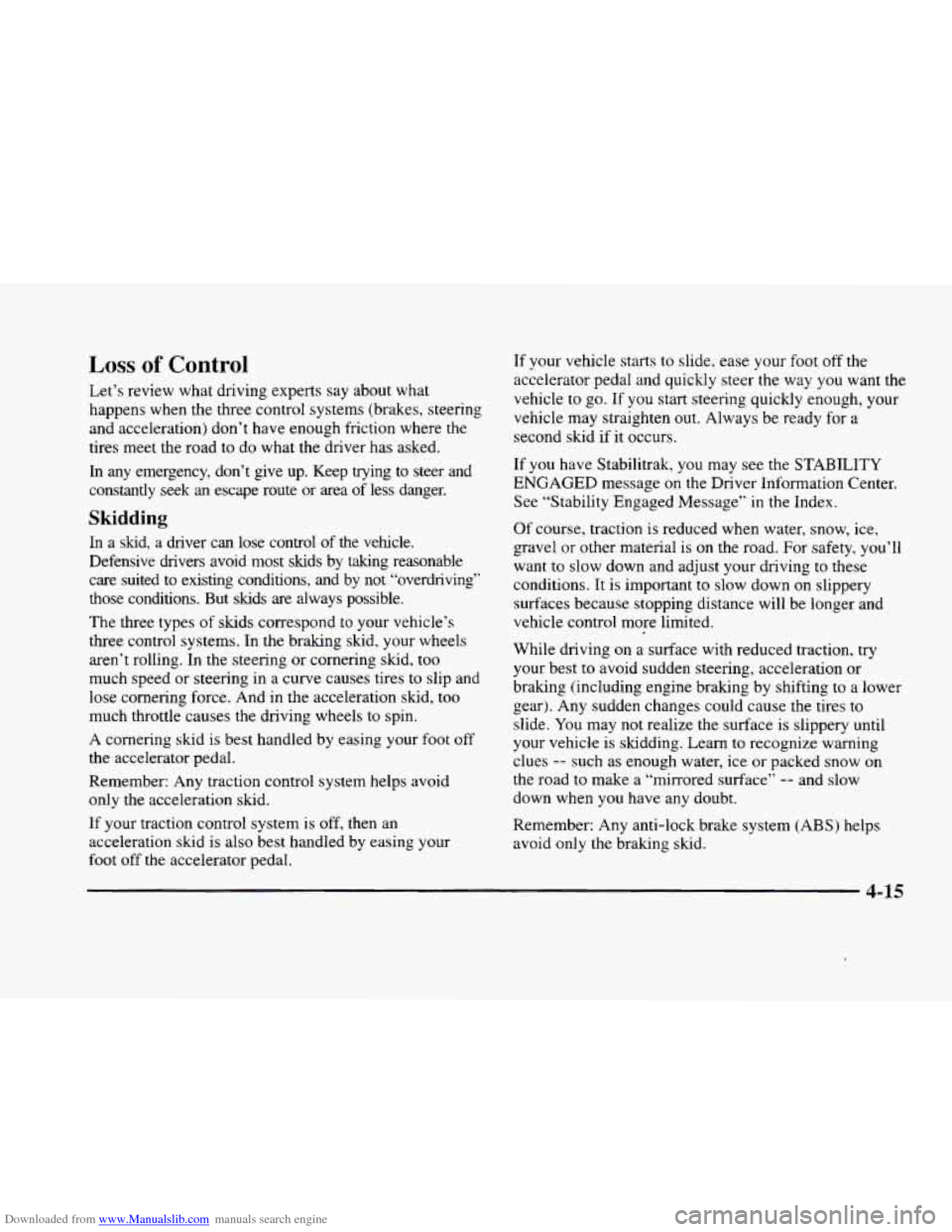
Downloaded from www.Manualslib.com manuals search engine Loss of Control
Let’s review what driving experts say about what
happens when the three control systems (brakes, steering
and acceleration) don’t have enough friction where the
tires meet the road to do what the driver has asked.
In any emergency, don’t give up. Keep trying to steer and
constantly seek
an escape route or area of less danger.
Skidding
In a skid, a driver can lose control of the vehicle.
Defensive drivers avoid most skids by taking reasonable
care suited to existing conditions, and by not “overdriving“
those conditions. But skids are always possible.
The three types
of skids correspond to your vehicle’s
three control systems. In the braking skid, your wheels
aren’t rolling. In the steering or cornering skid, too
much speed or steering in a curve causes tires to slip and
lose cornering force. And
in the acceleration skid, too
much throttle causes the driving wheels to spin.
A cornering skid is best handled by easing your foot off
the accelerator pedal.
Remember: Any traction control system helps avoid
only the acceleration skid.
If your traction control system is off, then an
acceleration skid is also best handled by easing your
foot
off the accelerator pedal. If
your vehicle starts
to slide, ease your foot off the
accelerator pedal and quickly steer the way you want the
vehicle to go.
If you start steering quickly enough, your
vehicle may straighten out. Always be ready
for a
second skid if it occurs.
If you have Stabilitrak,
you may see the STABILITY
ENGAGED message
on the Driver Information Center.
See “Stability Engaged Message” in the Index.
Of course, traction is reduced when water, snow, ice,
gravel
or other material is on the road. For safety, you’ll
want to slow down and adjust your driving to these
conditions.
It is important to slow down on slippery
surfaces because stopping distance will be longer and
vehicle control more limited.
While driving
on a surface with reduced traction, try
your best
to avoid sudden steering, acceleration or
braking (including engine braking by shifting to a lower
gear). Any sudden changes could cause the tires to
slide.
You may not realize the surface is slippery until
your vehicle is skidding. Learn to recognize warning
clues
-- such as enough water, ice or packed snow on
the road
to make a “mirrored surface” -- and slow
down when you have any doubt.
Remember: Any anti-lock brake system (ABS) helps
avoid only the braking skid.
4-15
Page 216 of 380
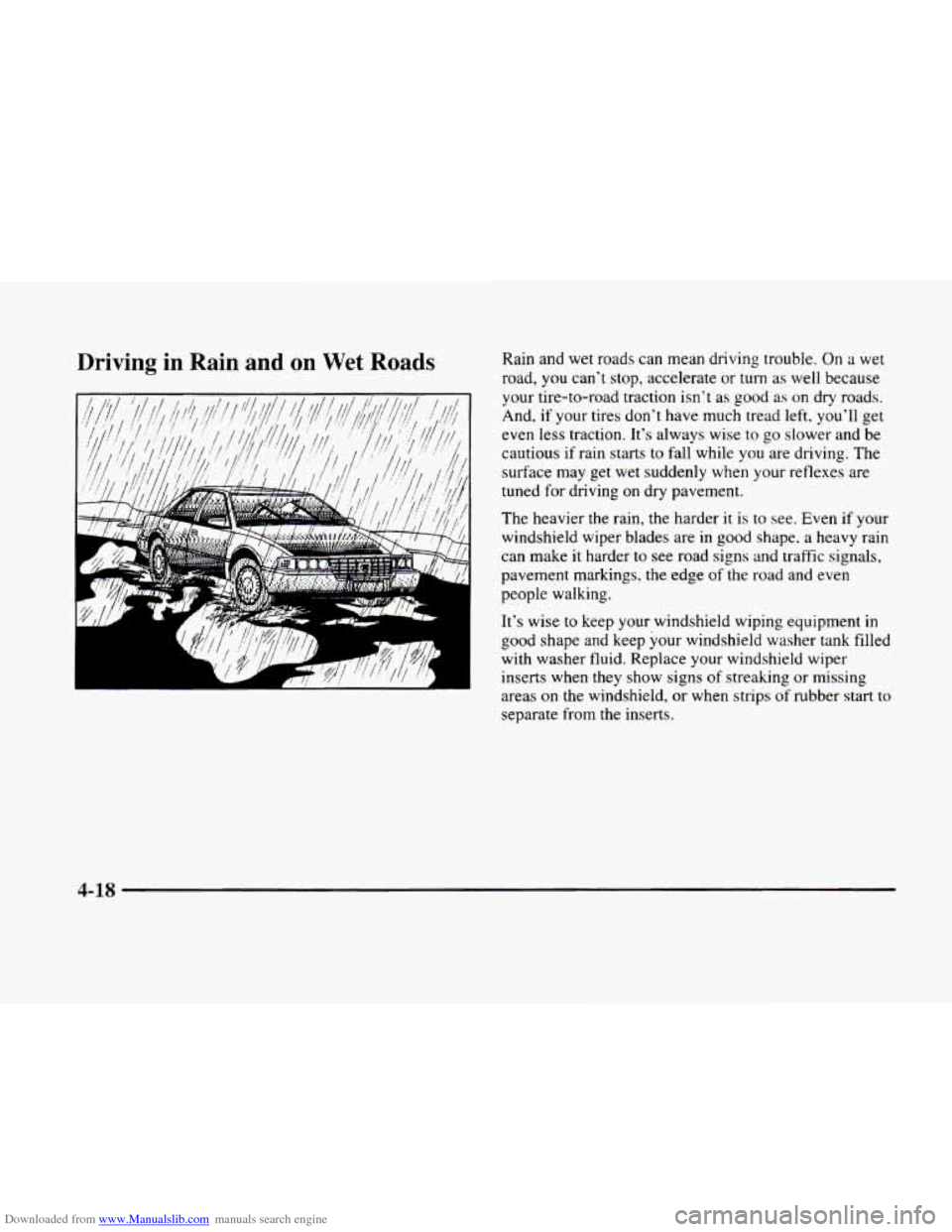
Downloaded from www.Manualslib.com manuals search engine Driving in Rain and on Wet Roads Rain and wet roaas can mean ariving trouble. On a wet
road,
you can‘t stop, accelerate or turn as well because
your tire-to-road traction isn’t as good
as on dry roads.
And,
if your tires don’t have much tread left, you’ll get
even less traction. It’s always wise to
go slower and be
cautious
if rain starts to fall while you are driving. The
surface may get wet suddenly when your reflexes are
tuned for driving on dry pavement.
The heavier the rain, the harder
it is to see. Even if your
windshield wiper blades are in good shape, a heavy rain
can make
it harder to see road signs and traffic signals,
pavement markings, the edge
of the road and even
people walking.
It’s wise to keep your windshield wiping equipment in
good shape and keep your windshield washer tank filled
with washer fluid. Replace your windshield wiper
inserts when they show signs
of streaking or missing
areas on the windshield, or when strips of rubber start to
separate from the inserts.
4-18
Page 217 of 380
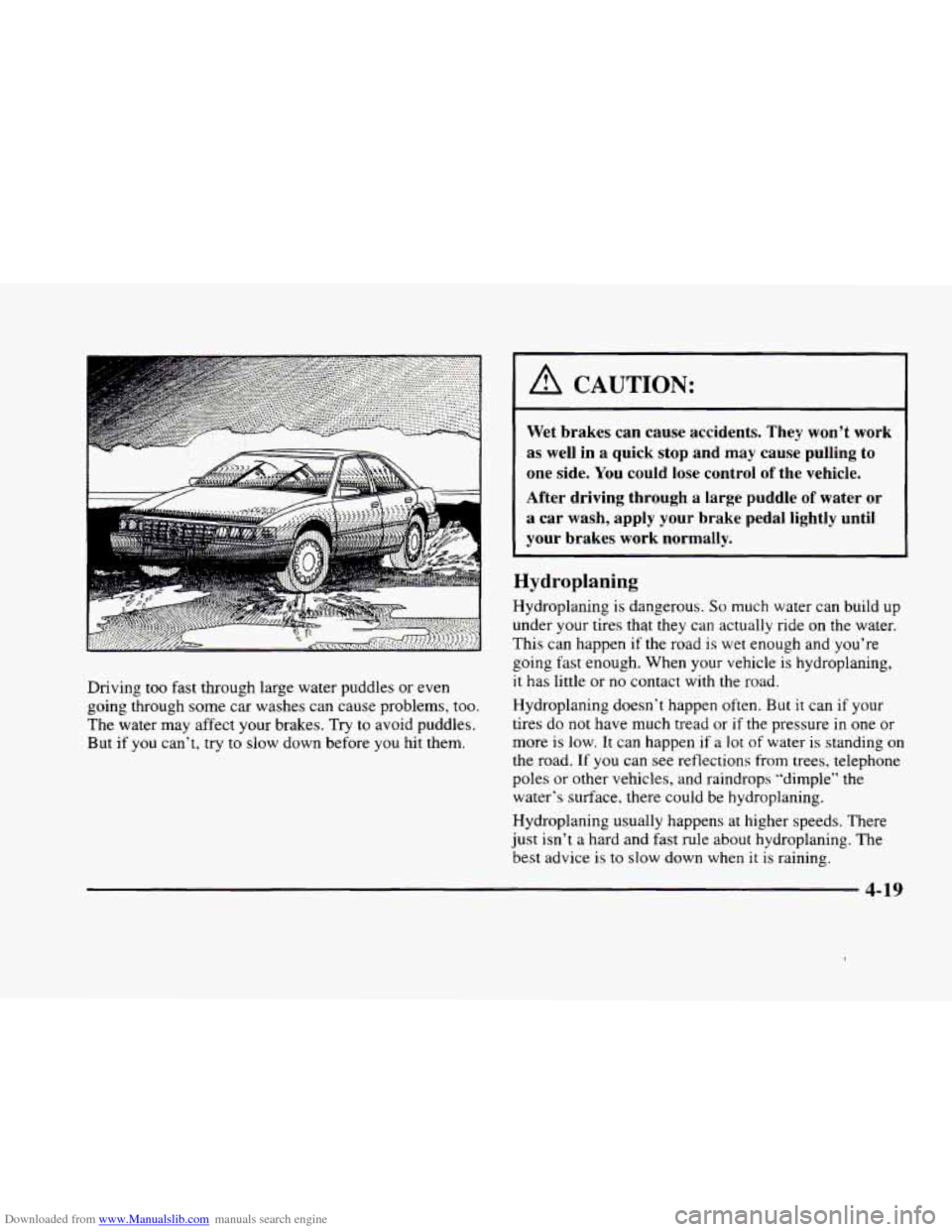
Downloaded from www.Manualslib.com manuals search engine I
Driving too fast through large water puddles or even
going through some car washes can cause problems, too.
The water may affect your brakes.
Try to avoid puddles.
But if
you can’t, try to slow down before you hit them.
A CAUTION:
Wet brakes can cause accidents. They won’t work
as well in a quick stop and may cause pulling to
one side.
You could lose control of the vehicle.
After driving through a large puddle of water or
a car wash, apply your brake pedal lightly until
your brakes work normally.
Hydroplaning
Hydroplaning is dangerous. So much water can build up
under your tires that they can actually ride on the water.
This can happen if the road is wet enough and you’re
going fast enough. When your vehicle
is hydroplaning,
it has little or no contact with the road.
Hydroplaning doesn’t happen often.
But it can if your
tires do not have much tread or
if the pressure in one or
more is low. It can happen if a lot of water is standing on
the road. If you can see reflections from trees, telephone
poles
or other vehicles, and raindrops “dimple” the
water’s surface. there could be hydroplaning.
Hydroplaning usually happens at higher speeds. There
just isn’t a hard and fast rule about hydroplaning. The
best advice is to slow down when it
is raining.
Page 218 of 380
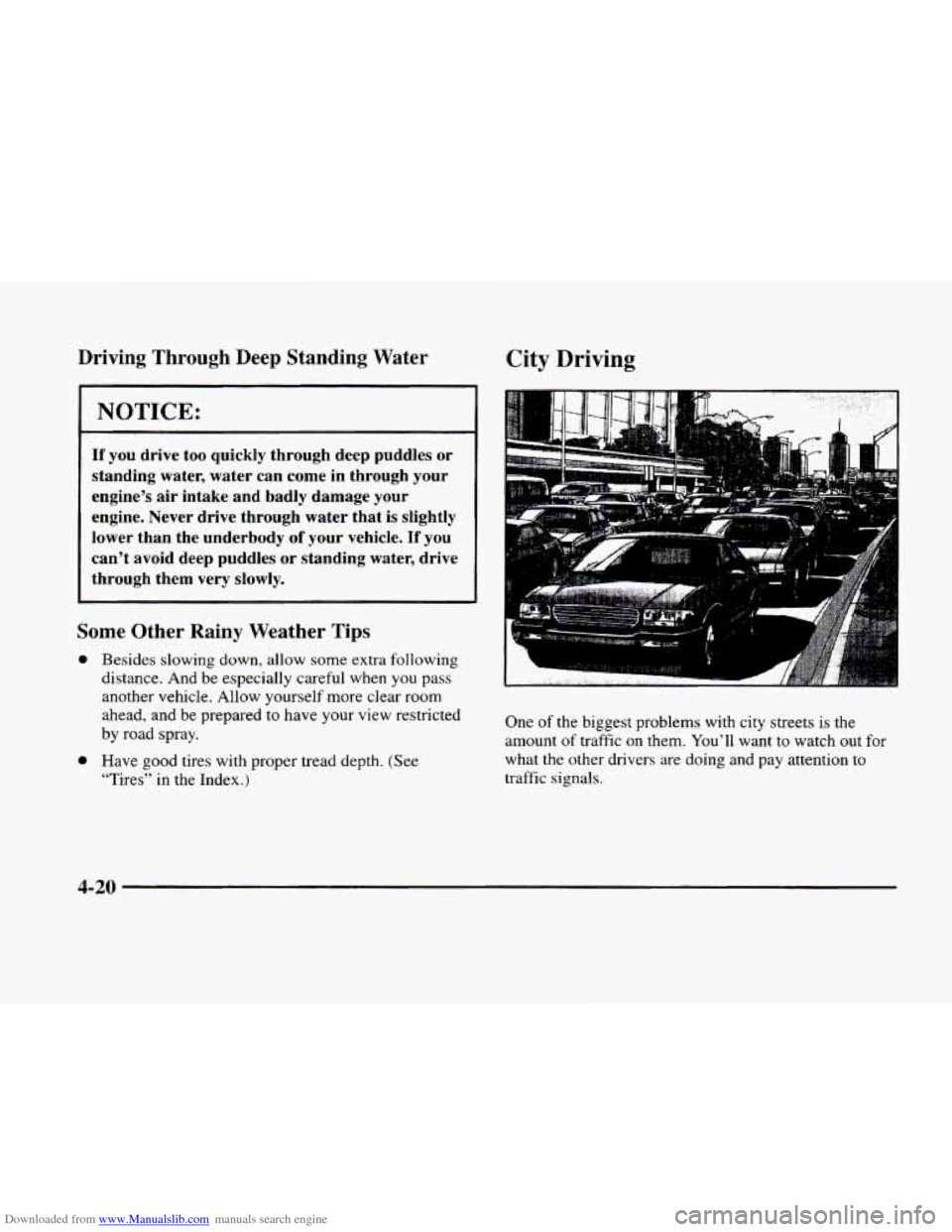
Downloaded from www.Manualslib.com manuals search engine Driving Through Deep Standing Water City Driving
NOTICE:
If you drive too quickly through deep puddles or
standing water, water can come in through your
engine’s air intake and badly damage your
engine. Never drive through water that is slightly
lower than the underbody
of your vehicle. If you
can’t avoid deep puddles or standing water, drive
through them very slowly.
some Other Rainy Weather Tips
0
0
Besides slowing down, allow some extra following
distance. And be especially careful when you pass
another vehicle. Allow yourself .more clear room
ahead, and be prepared to have your view restricted
by road spray.
Have good tires with proper tread depth. (See
“Tires” in
the Index.)
L
One of the biggest problems with city streets is the
amount of traffic on them. You’ll want to watch out
for
what the other drivers are doing and pay attention to
traffic signals.
4-20